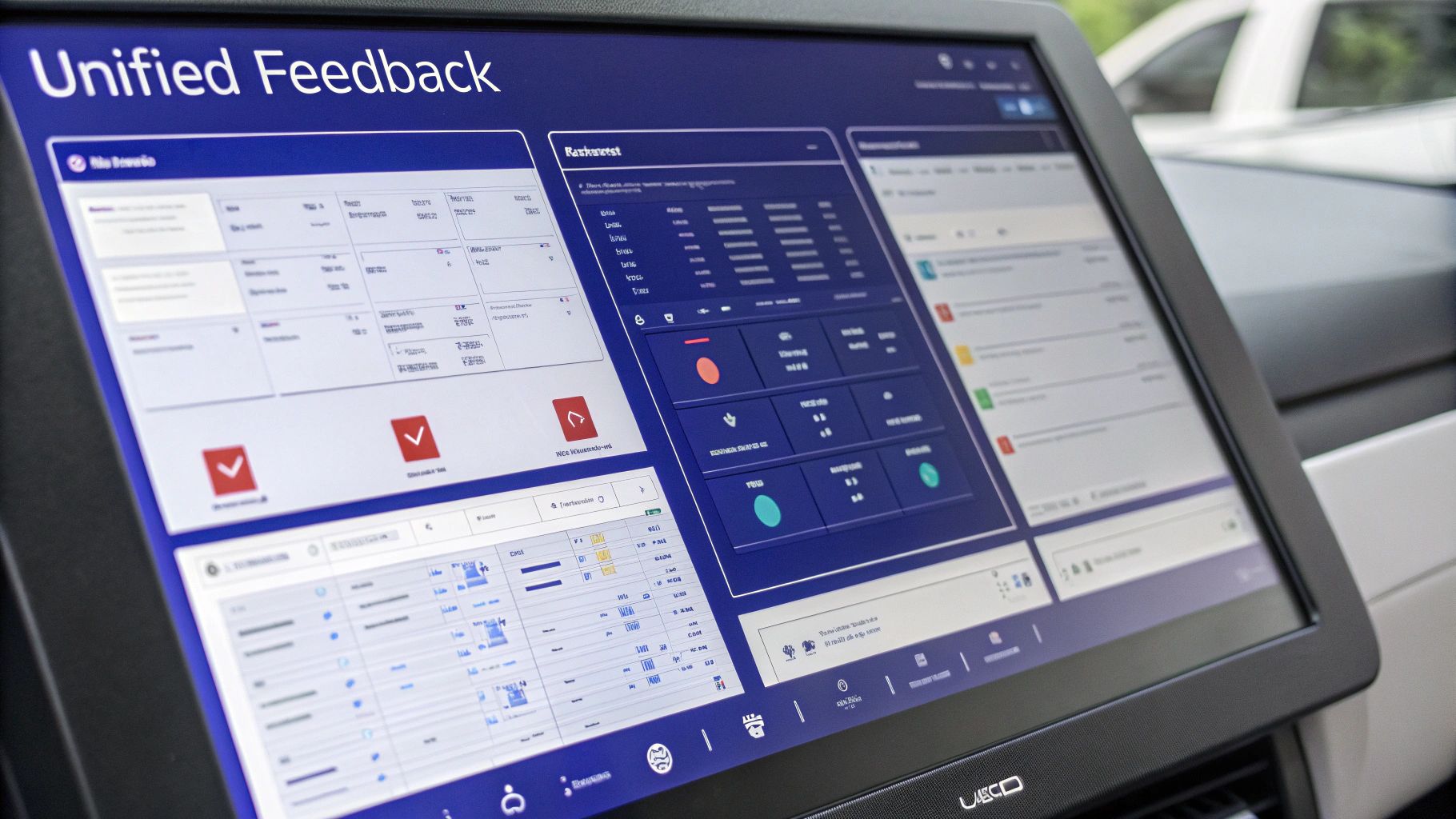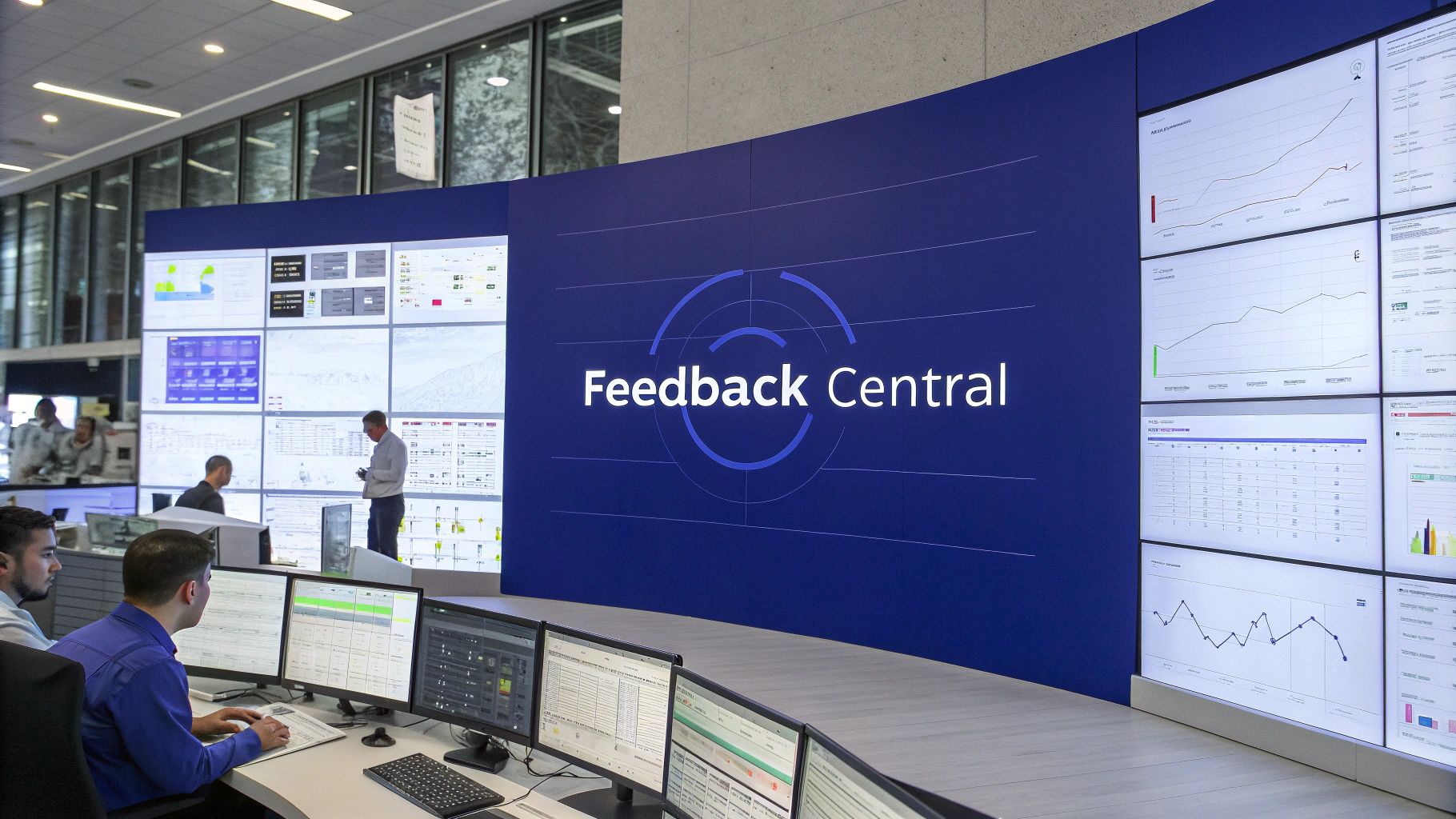Introduction to Centralized Feedback Management

In the intricate world of modern business, understanding customer feedback is essential for success. This understanding hinges on effective feedback management, and this is where centralized feedback management enters the picture. Centralized feedback management consolidates all feedback from various sources into a single, unified system. This means businesses can move away from feedback scattered across emails, spreadsheets, and various platforms to a central repository. As a result, organizations gain a complete view of customer, employee, and stakeholder opinions, allowing them to make more informed decisions. This consolidated perspective is critical for businesses seeking a comprehensive understanding of their performance and areas for improvement.
Why Centralize Feedback?
Imagine trying to assemble a puzzle with pieces strewn across several rooms. This analogy aptly describes the difficulty of managing decentralized feedback. When feedback resides in multiple, disconnected locations, identifying meaningful trends and patterns becomes a significant hurdle. Centralized feedback management, however, simplifies this process by collecting all the "puzzle pieces" into one accessible location. This improved visibility allows organizations to identify recurring issues, understand customer sentiment, and gauge the effectiveness of implemented changes. For instance, if several customers report the same bug in a software application, a centralized system immediately flags this issue, enabling a rapid response and preventing further customer dissatisfaction. Moreover, this centralized approach facilitates more efficient analysis and reporting, saving valuable time and resources.
Key Components of Centralized Feedback Management
Centralized feedback management is more than simply collecting feedback; it’s about establishing a system that facilitates effective action. This system relies on several interconnected components. First, data integration connects all feedback sources – such as CRM systems, survey tools, and social media platforms – into the central repository, providing a complete overview of all incoming feedback. Next, robust analysis and reporting tools are crucial for identifying trends and extracting actionable insights from this consolidated data. This analysis might include sentiment analysis, theme identification, and trend tracking. Furthermore, workflow automation streamlines tasks like feedback routing, notifications, and follow-ups, ensuring timely responses and improved efficiency. Finally, action management capabilities facilitate the assignment and tracking of actions based on the received feedback. This promotes accountability and allows for the measurement of the impact of implemented changes. These integrated components make centralized feedback management a potent tool for organizations looking to optimize operations and enhance the customer experience. By consolidating, analyzing, and acting on feedback, businesses can gain a competitive advantage and build stronger stakeholder relationships.
Benefits of Centralized Feedback Systems

As established, collecting feedback from diverse sources is essential for organizational success. This is where the true value of centralized feedback management emerges. By consolidating all feedback into a unified system, businesses unlock a range of advantages that directly contribute to enhanced performance and customer satisfaction. This means valuable insights are no longer confined to individual departments, but are readily accessible to inform crucial decisions across the organization.
Enhanced Efficiency and Productivity
A primary benefit of centralized feedback management is increased efficiency. No longer do teams need to sift through countless emails, spreadsheets, and individual software platforms to locate the feedback they need. A centralized system eliminates this tedious process, freeing up valuable time and resources. This allows teams to dedicate their efforts to analyzing feedback and implementing changes, rather than manual data collection and consolidation. This optimized workflow naturally translates into increased productivity throughout the organization.
Data Consistency and Actionable Insights
Centralized feedback management also promotes data consistency. With all feedback gathered in one location, using a standardized format, analysis becomes significantly easier. This consistent data forms a reliable basis for deriving actionable insights. For instance, consistent data can reveal customer behavior patterns, recurring product issues, or service areas needing improvement. These insights are invaluable for making informed decisions about product development, customer service strategies, and overall business operations.
Improved Decision-Making and Responsiveness
Access to a comprehensive view of customer feedback empowers organizations to make more data-driven decisions. Rather than relying on anecdotal evidence or fragmented information, businesses can base their decisions on comprehensive data reflecting the collective customer voice. This results in more effective solutions and targeted improvements. Moreover, centralized feedback management enables faster response times. When feedback is readily available and easily accessible, organizations can address customer concerns and issues more promptly. This increased responsiveness contributes to enhanced customer satisfaction and strengthens loyalty. You might be interested in: How a feedback tool helps product managers share feedback quickly across teams.
Fostering Collaboration and Transparency
Centralized feedback management also promotes collaboration and transparency within the organization. By providing a shared platform for feedback, it ensures all stakeholders have access to the same information. This shared understanding of customer opinions and concerns fosters alignment between teams and departments. This, in turn, leads to a more cohesive and effective approach to addressing customer needs. The transparency provided by centralized feedback management also builds trust with customers, demonstrating a commitment to listening and responding to their feedback. Ultimately, this strengthens customer relationships and reinforces a customer-centric approach throughout the organization. This structured approach to feedback management ensures that no feedback is overlooked and all valuable insights are captured, contributing to a deeper understanding of the customer experience.
Implementation Strategies
Successfully implementing a centralized feedback management system requires careful planning and execution. This section outlines a strategic approach to implementation, ensuring alignment with organizational objectives and maximizing the value of collected feedback. This methodical implementation is essential for realizing the full potential of centralized feedback management.
Phase 1: Assessment and Planning
Before implementing a system, it's crucial to assess the current state of feedback management within the organization. This involves identifying all existing feedback channels, understanding the types of feedback being collected, and evaluating the current tools and processes. This initial assessment forms the basis for a tailored implementation strategy. For example, you might find feedback dispersed across email inboxes, customer support tickets, and social media comments. This fragmented approach makes it challenging to gain a holistic view of customer sentiment. Understanding this current state helps pinpoint gaps and define clear objectives for the centralized system. Next, define specific, measurable, achievable, relevant, and time-bound (SMART) goals for centralized feedback management. These goals might include improving customer satisfaction scores, reducing customer churn, or accelerating product development cycles. This provides clarity of purpose for the system and facilitates measuring its effectiveness. Check out our guide on How to Centralize Team Feedback. Finally, develop a comprehensive implementation plan outlining the steps, timelines, and resources required for each phase. This structured approach ensures a smooth transition and minimizes potential disruptions.
Phase 2: System Selection and Integration
Selecting the right feedback management platform is crucial to the system's success. Consider factors such as data integration capabilities, reporting and analytics features, workflow automation options, and scalability for future growth. The chosen platform should align with the organization's specific needs and objectives. Once a platform is selected, the next step is to integrate it with existing systems, such as CRM software, marketing automation tools, and product management platforms. This ensures a seamless flow of feedback data into the central repository. This integration is vital for gaining a comprehensive view of customer interactions and feedback. For example, integrating with a CRM system allows you to link feedback directly to specific customer profiles, providing invaluable context for analysis.
Phase 3: Process Definition and Training
Clearly defined processes for feedback collection, analysis, and action are essential for ensuring consistency and efficiency. This entails establishing guidelines for feedback categorization, response protocols, and workflow automation rules. These standardized processes streamline the feedback management workflow and ensure that no feedback is missed. Additionally, provide thorough training to all team members using the centralized feedback management system. This training should cover system navigation, feedback processing procedures, and best practices for extracting actionable insights from the data. Properly equipping team members maximizes the system’s effectiveness.
Phase 4: Ongoing Monitoring and Optimization
Implementing a centralized feedback management system isn't a one-time endeavor; it requires ongoing monitoring and optimization to ensure continued effectiveness. This involves regularly reviewing system performance, analyzing feedback data for trends and patterns, and adjusting processes and tools as needed. This continuous improvement approach ensures the system adapts to evolving organizational needs and maximizes its value. For instance, if certain feedback categories consistently generate valuable insights, the system can be refined to prioritize these categories and automate their processing. This proactive approach to optimization ensures that centralized feedback management remains a powerful tool for organizational growth and customer satisfaction.
Best Practices and Tools

Implementing a centralized feedback management system is just the first step. To truly unlock its potential, organizations must adopt best practices and utilize the right tools. This combination ensures optimal system function, providing valuable insights and driving continuous improvement. This section explores these crucial elements for maximizing the effectiveness of centralized feedback management.
Prioritizing Actionable Feedback
Not all feedback carries equal weight. Some feedback offers valuable insights for immediate action, while other feedback may be less relevant or actionable. Prioritizing feedback based on its potential impact and relevance to organizational goals is therefore a critical best practice. This ensures resources are focused on addressing the most important issues and opportunities. For example, feedback concerning critical bugs in a software product should take precedence over suggestions for minor cosmetic changes.
Establishing Clear Feedback Loops
Effective centralized feedback management relies on establishing clear and efficient feedback loops. This means defining a clear process for collecting, analyzing, and acting upon feedback, as well as communicating updates and resolutions to stakeholders. This transparent process ensures that feedback is addressed promptly and efficiently, improving customer satisfaction and increasing stakeholder engagement. For instance, a feedback loop might involve automatically routing customer feedback to the correct product team, assigning tasks for investigation and resolution, and notifying the customer about the outcome.
Regularly Reviewing the System
Centralized feedback management systems are not static; they require regular review and adjustment for continued effectiveness. This ongoing evaluation should assess the system's performance against predefined metrics, identify areas for improvement, and adapt to changing business needs. This dynamic approach ensures that the system remains relevant and valuable over time. For example, if analysis reveals a particular feedback channel is yielding low-quality insights, the organization might choose to redirect resources to other, more productive channels.
Utilizing Effective Tools
The right tools are essential for efficient and effective centralized feedback management. A variety of tools, from dedicated feedback management platforms to CRM systems, can facilitate this process. Selecting the right tool depends on the specific needs of the organization and the type of feedback being collected. For example, platforms like BugSmash provide a central repository for feedback on media files, streamlining the review and annotation process. This centralized approach benefits product teams, marketing teams, and individual creators. Integrating with other tools, such as survey platforms and social media monitoring tools, further enhances the comprehensiveness of the centralized feedback management system. Leveraging these tools strengthens the overall feedback management strategy, ensuring valuable insights are captured and acted upon, which ultimately contributes to organizational growth and customer satisfaction.
Common Challenges and Solutions

While centralized feedback management offers significant advantages, implementing and maintaining such a system presents certain challenges. However, careful planning and effective strategies can address these obstacles. This section examines common challenges organizations encounter with centralized feedback management and proposes practical solutions.
Data Silos and Integration Hurdles
One primary challenge is breaking down existing data silos. Feedback often resides in disparate systems across the organization, from CRM software to individual team spreadsheets. Integrating these diverse data sources into a unified system can be complex and time-consuming, yet it is essential for obtaining a holistic view of customer feedback. The solution lies in choosing a feedback management platform with strong integration capabilities. A platform that seamlessly connects with various data sources through APIs or other integration methods streamlines this consolidation process. A phased approach to integration, starting with the most critical data sources, can minimize disruption and make implementation more manageable.
Maintaining Data Quality and Consistency
Another challenge is maintaining the quality and consistency of feedback data. Different feedback channels may employ various formats and terminology, making it difficult to compare and analyze feedback effectively. This inconsistency hinders the identification of meaningful trends and insights. The solution is to establish clear data standardization guidelines. This could involve defining common feedback categories, using standardized question formats in surveys, and implementing data validation rules within the feedback management system. This ensures consistency and comparability across all data sources, facilitating more accurate analysis.
Overwhelmed by Feedback Volume
Centralizing feedback can lead to a significant increase in the volume of feedback collected. This influx can overwhelm teams, making it difficult to prioritize and respond effectively. Without a strategy for managing this increased volume, valuable insights can be missed, and customer satisfaction can suffer. Implementing a tiered approach to feedback management can address this. This involves categorizing feedback based on urgency and importance, allowing teams to address the most critical issues first. Workflow automation also plays a crucial role, automatically routing feedback to the appropriate teams and triggering notifications for urgent matters. This streamlines the process and ensures no feedback is overlooked.
Demonstrating ROI and Securing Buy-in
Demonstrating the return on investment (ROI) of centralized feedback management can also be challenging. While the benefits are numerous, quantifying the impact on business outcomes like increased customer retention or improved product development can be difficult. This can hinder securing buy-in from stakeholders and justifying the investment. The key is to establish clear, measurable goals for centralized feedback management from the start. These goals should be tied to key business metrics like customer satisfaction scores, conversion rates, or product development cycle times. Tracking these metrics before and after implementation allows organizations to quantify the system's impact and demonstrate its value to stakeholders. For example, tracking the speed of customer issue resolution after implementing a centralized system provides concrete evidence of improved efficiency and responsiveness. Using platforms like BugSmash, designed to streamline feedback processes, can enhance efficiency and demonstrate a tangible ROI. This data-driven approach positions centralized feedback management as a valuable investment contributing to organizational growth and customer satisfaction.
Future Trends
The field of centralized feedback management is constantly evolving, shaped by technological advancements and a growing understanding of customer behavior. These emerging trends are shaping how organizations collect, analyze, and act upon feedback, making it crucial for businesses to stay informed and adapt their strategies to maximize the value of their feedback management systems.
AI-Powered Feedback Analysis
The increasing use of AI in feedback analysis is a prominent trend. AI algorithms can analyze vast datasets, identifying patterns and sentiments that would be impossible for humans to detect manually. This automated analysis provides deeper insights into customer needs and preferences, enabling organizations to personalize their offerings and improve the customer experience. For example, AI can analyze open-ended survey responses to identify recurring themes and sentiments, providing a nuanced understanding of customer opinions.
Predictive Analytics for Proactive Engagement
Predictive analytics is gaining traction in centralized feedback management. By analyzing historical feedback data, AI can predict future customer behavior and identify potential issues before they escalate. This proactive approach allows organizations to address customer concerns preemptively, enhancing customer satisfaction and loyalty. This shift from reactive to proactive problem-solving creates a more positive customer experience.
The Rise of Real-Time Feedback
Real-time feedback is also becoming increasingly important. Organizations are seeking ways to collect feedback in the moment, enabling immediate issue resolution and instant support. This real-time engagement creates a sense of responsiveness and strengthens customer relationships. For example, integrating feedback tools directly into websites or applications enables customers to provide instant feedback, allowing businesses to address issues immediately, preventing frustration and enhancing the user experience.
Integration with Other Business Systems
The seamless integration of centralized feedback management systems with other business systems, like CRM platforms and marketing automation tools, is a growing trend. This interconnectedness provides a holistic view of the customer journey, allowing organizations to personalize interactions and optimize marketing campaigns based on feedback data. This deeper integration enhances the value of centralized feedback management, enabling more informed decisions and overall performance improvement.
Ready to streamline your feedback management process and leverage the power of these future trends? Try BugSmash today and experience the difference a centralized feedback platform can make. Start your free trial now!



